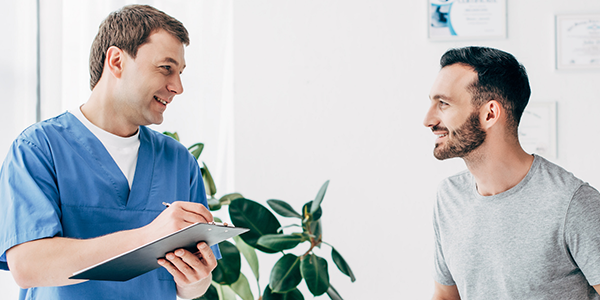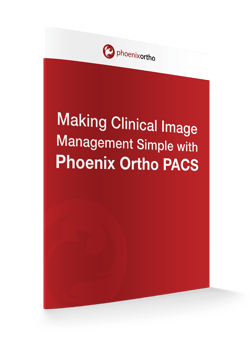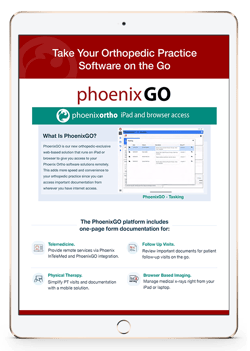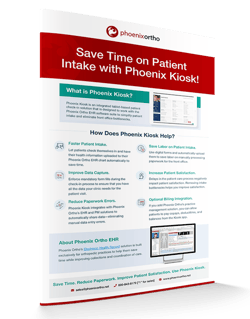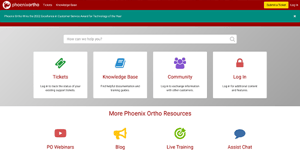How much time does your orthopedic practice lose to small inefficiencies on a daily basis? How much lost time does that add up to over the course of a week, a month, or a year? Are resources getting wasted due to inefficiencies in the practice? Almost every orthopedic clinic has at least some waste in its processes. By eliminating that waste, clinics can improve their return on investment (ROI) for every dollar they spend on their operations.
Finding ways to eliminate inefficiencies is a crucial skill for orthopedic surgeons, as it helps them save time and improve their cash flow. In this post, we’ll cover some common waste factors and some ways to improve efficiency.
Top 6 Time and Resource Wasters in Orthopedic Clinics
There are many ways that a clinic can end up wasting resources. To eliminate wasted resources in everyday processes, it’s important to know what the biggest sources of waste are. Some of the most common sources of waste include:
1. Patient Visit Paperwork
How much time do you spend on paperwork for every patient you see? If you’re anything like the average orthopedic surgeon, you probably spend several hours on paperwork on top of the time you spend actually helping patients. This is almost like having a second full-time job that sucks up all of your time and energy.
According to the American Medical Association, 32% of doctors (in all specialties) spend 20 or more hours per week on paperwork and other administrative tasks, while 38% spend between 10 and 19 hours per week on these tasks.
Orthopedic physicians tend to see more patients per day than doctors in other specialties, so they have even more paperwork that they need to keep up with. For example, a general practitioner in a primary care facility might see 10-15 patients per day. Meanwhile, an orthopedic specialist might see upwards of 60 patients in a day. Even if paperwork only took five minutes per patient, that’s still five hours of extra work per day. Shaving just one or two minutes off of each patient’s paperwork could save an entire day’s worth of work each week.
2. Waiting for Orthopedic Surgery Approvals
Orthopedic surgeons often have to schedule specialized surgical procedures for their patients. However, navigating the complex web of what insurance providers (and other payer organizations) will or won’t cover can be a massive headache. Some insurers may take forever to approve a specific procedure, refuse to cover a procedure that should be within the patient’s policy, or change their billing codes so that previously accepted codes stop working.
This often delays the surgeon’s ability to schedule a surgery for a patient. This not only delays the patient from receiving necessary medical care, but it can also keep the clinic from being able to collect on those surgeries—delaying cash flow.
3. Over- and Under-Ordering of Supplies
Orthopedic clinics often need to have a steady supply of both durable medical equipment (DME) and single-use supplies on hand for different procedures. When supplies run short, the clinic runs the risk of not being able to perform certain services that patients need. On the other hand, ordering too much means wasting money on extra storage space or on supplies that aren’t going to be used in the foreseeable future.
So, orthopedic clinics need to have a system in place to manage the ordering of new supplies to prevent both shortages and overages of specific items.
4. Claims Rejections
It can be frustrating for any orthopedic surgeon to provide a patient with necessary care only to be refused by the patient’s payer organization when the bill gets sent out. When claims for services rendered are rejected, it can have a significant impact on the clinic’s income.
First, the clinic needs to examine the reason for the rejection and determine how it can be overcome. Sometimes, this can be as simple as resubmitting the claim with a modified billing code. At other times, the clinic may not be able to collect from the payer and may need to recoup its costs from the patient directly. Either way, the orthopedic ROI for services provided is delayed or lost.
5. Patient No-Shows
When a patient doesn’t show up for a visit (whether it’s because they’re not engaged with their health care needs or are dissatisfied with the clinic), that can be a drain on the clinic’s resources as staff are forced to wait for a patient who isn’t coming.
Why? Because, for every no-show, orthopedic surgeons have to sit on standby just in case the patient arrives late, other patients are forced to wait a bit longer for service, and fewer people get seen each day—which hurts the clinic’s revenue.
6. Manual Data Entry Errors
Nobody’s perfect. Everybody will make a mistake sooner or later when submitting a form, image request, or some other piece of manual paperwork. The problem in an orthopedic clinic is that everyone is pressed for time—from the orthopedic surgeon, to their assistants, to the front office staff.
With so much pressure and so little time, it’s all too easy for mistakes to be made on manually-filled paperwork. This can lead to delays from claims rejections, being unable to find misfiled paperwork, and other issues later on.
How to Improve Clinical Efficiencies with Orthopedic-Exclusive EHR Solutions
So, how can a clinic address the sources of waste outlined above? One solution is to use technology to help improve the consistency, speed, and efficiency of related tasks. Here are a few ways that technology like orthopedic-exclusive Electronic Health Records (EHR) solutions and other software can help:
- Minimizing Paperwork. As the only orthopedic-exclusive EHR vendor, Phoenix Ortho’s EHR solution excels at eliminating unnecessary paperwork and saving time. With an orthopedics-only EHR, surgeons are presented with just the form fields that are important to their practice—not ones meant for primary care facilities that are separate from orthopedic care. By reducing paperwork complexity, an orthopedic-exclusive EHR can save a lot of time and mouse clicks while reducing the risk of human error.
- Automating Information Sharing. One of the major challenges that orthopedic clinics face is gathering important patient data. Everything from the patient’s medical history, current visit data, orthopedic images, and more needs to be at the orthopedic surgeon’s fingertips at a moment’s notice. However, manual data entry methods (even on digital platforms) increases the risk of important data being missed or attached to the wrong patient chart. Automated systems, such as patient check-in kiosk systems, integrated picture archiving and communication system (PACS) software, and the like which simplify information collection and associate data with the correct patient chart can help eliminate the risk of human error.
- Managing Inventory. A DME inventory management solution can do a lot to simplify the management of commonly-used equipment in the orthopedic practice (such as crutches, wheelchairs, and walkers). DME software can help keep track of medical equipment codes, send out reminders when DME inventory hits a specified threshold, and help trace equipment to prevent inventory shrinkage that negatively impacts orthopedic revenue.
- Preemptively Collecting Surgery Eligibility Information. Waiting for approval for orthopedic surgery can delay the actual scheduling of that surgery—which impacts both the ability to collect on services rendered and patient satisfaction.
- Automating Patient Visit Reminders. Many patients are very busy and may forget about important examination or treatment follow-up dates if they don’t get a reminder. However, reaching out manually to every patient who has a scheduled appointment for treatment can be a major time sink. Here, practice management software can help save time and reduce no-shows by sending automated reminders to patients. From simple emails the week of the visit to text messages and automated voice recordings, orthopedic software can make it easy to send reminders automatically so patients don’t accidentally forget about their appointments.
- Simplifying Payment Collection. One of the biggest ways to get an ROI out of orthopedic software is to use it to improve the clinic’s billing systems. For example, electronic payment solutions on patient check-in kiosks (or online websites) can allow orthopedic practices to collect payments from patients before their next visit. Additionally, EHRs that can automatically assess which Evaluation and Management (E & M) codes to apply to a patient visit can help maximize collections while minimizing the risk of rejected claims and billing code audits. Both of these practices help to improve cash flow for the clinic.
There are many ways to use orthopedic software to eliminate inefficiencies and improve profitability in an orthopedic practice.
If you’re ready to revolutionize your orthopedic clinic to save time and money while maximizing revenue, reach out to Phoenix Ortho to get more information about our orthopedic-exclusive software solutions!
Schedule a 1:1
Get in touch with Phoenix Ortho to learn more about how you can save time, money, and mouse clicks with an orthopedic-specific EHR.

